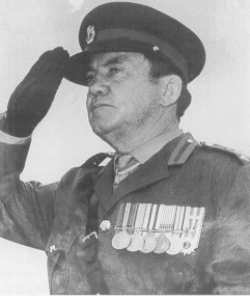
The exact origin of the military salute has been lost in time, however it is believed that it probably originated first by showing that the right hand (the fighting hand) was not concealing a weapon. Another line of thought is, when men-at-arms took to wearing armour, the approaching generals or king would ride forward and, holding the reins of the horse with the left hand, they would raise the visor with the right to identify each other.
When a knight or a king wanted to raise an army he would ride around his people to enlist men-at-arms. Only free men were allowed to bear arms and they would show their availability by looking their king or knight in the eyes (a serf, or slave, had to bow his head and eyes toward the ground). Today the custom is carried-out as the Eyes Right on the ceremonial march past and when a marching body of troops pass by an officer.
The protocol of paying compliments to armed bodies of troops (Armed Corps or Armed Party) also goes back hundreds of years. If a lone soldier didn’t stand-fast for a passing body of armed troops and declare his allegiance, the party would assume him to be hostile and treat him accordingly.
The sword salute was reminiscent of the Crusader days when the knight kissed the hilt of the sword before entering conflict. The hilt represented the Cross and the motions of the salute roughly described the Cross. Today some of the motions of the salute have been omitted; the ‘Recover’ is, however, still symbolic of kissing a Cross.
Whilst drills change with each new rifle, the rifle salute of today is based on a drill where the salute was the first motion of ‘Present Arms’. A sentry’s salute to an officer of, or above field rank (major) was, and still is, a full salute with the weapon, the ‘Present Arms’. Junior officers received the preliminary movement only, hence the ‘rifle’, or ‘butt’ salute.
© Warrant Officer C. JOBSON 1998





